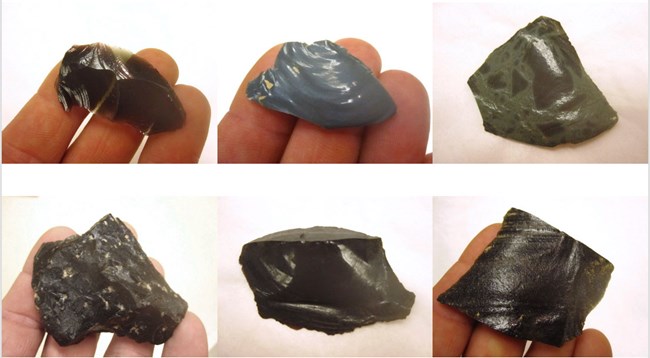Last updated: January 25, 2022
Article
Obsidian Sources from Southeast Alaska

In this study archaeologists looked at stone implements--microblade cores--made of obsidian from prehistoric sites across Southeast Alaska that are dated to roughly 10,000 years ago. The suite of six sites (Groundhog Bay II, Hidden Falls, Irish Creek, Shuk‐Kaa Cave, Neck Lake Terrace, and Shaheen Falls) examined here mark the first archaeologically visible human occupation of the islands of Southeast Alaska.
Researchers used chemical analyses to recognize distinctive geochemical fingerprints of both artifacts and geological sources and, in turn, were able to reconstruct ancient paths of transport or trade. Most of the tools were found to come from a local source of high-quality obsidian found at Obsidian Cove on Suemez Island, Alaska and these were transported over distances up to 220 miles. A few obsidian cores were derived from a slightly closer source in interior British Columbia, Mount Edziza, at roughly 180 miles in a straight line distance, but which would have required a circuitous riverine or overland route to access. Prehistoric use of a newly documented source of obsidian from Zim Creek on Kupreanof Island, Alaska is described here for the first time.
Results overall suggest that from the earliest known occupations throughout the early Holocene, mobile foragers in Southeast Alaska gathered high‐quality obsidian from the “local” sources on Suemez Island. From the earliest known occupations, these foragers adapted their toolmaking techniques to produce microblades from the readily available small nodules at Obsidian Cove rather than relying on exchange networks with groups outside of Southeast Alaska for less accessible Mount Edziza obsidian. After roughly 5,500 years ago obsidian from Mount Edziza was once again present in Southeast Alaska and indicates more connectivity with groups outside of the archipelago.
Obsidian source classification and defining “local” in early Holocene Southeast Alaska
Abstract
Despite the ubiquity of obsidian in early Holocene archaeological assemblages across Southeast Alaska, artifact sourcing using bi-plots and Principal Component Analysis has been hampered by the highly correlated geochemistry of two major sources: local Aguada Cove on Suemez Island, and distant Mount Edziza, in the Coast Mountain range. Partial Least Squares Discriminant Analysis (PLS-DA) models constructed with device-specific portable X-ray fluorescence (pXRF) source catalogs benefit from the precision of individual pXRF machines and the ability of PLS-DA to handle highly correlated data sets to provide a source classification system that complements existing methods. Of the known obsidian sources in or near Southeast Alaska, four are identified in early Holocene archaeological assemblages: Obsidian Cove and Aguada Cove on Suemez Island, Mount Edziza in the Coast Mountain Range, and a newly identified source on Zim Creek, Kupreanof Island. A comprehensive reanalysis of early Holocene microblade cores (101 cores from 13 archaeological sites) across Southeast Alaska confirms the presence of exotic obsidian from Mount Edziza in one of the oldest sites, alongside possible evidence of landscape learning: testing of the obsidian source on Kupreanof Island. The dominance of the Obsidian Cove source for microblade core production supports hypotheses framing Northwest Coast microblade core morphology as an adaptation to the small nodules of raw material available at the source. A simple distance-decay model indicates no relationship between core reduction intensity and distance from the source, suggesting high forager mobility characterized by regular trips to Suemez Island (a voyage of up to 380 km) throughout the early Holocene.
Schmuck, N., R. J. Carlson, J. Reuther, J. F. Baichtal, D. H. Butler, E. Carlson, and J. T. Rasic. 2022. Obsidian source classification and defining “local” in early Holocene Southeast Alaska. Geoarchaeology 1-20.
